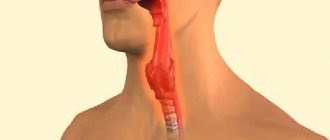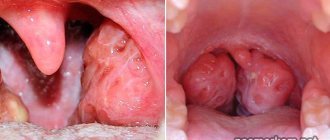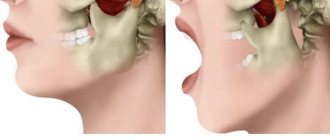Palatine tonsils - a focus of inflammation in chronic tonsillitis
In the upper respiratory tract of a person there are a number of formations representing an accumulation of lymphoid tissue, the so-called lymphoepithelial organs - tonsils. There is a whole lymphopharyngeal ring consisting of 7 tonsils. These are unpaired pharyngeal (adenoids), lingual, laryngeal tonsils, and paired palatine and tubal tonsils. Like any organ in our body, the tonsils can be subject to inflammatory diseases.
Acute inflammation of the tonsils is a sore throat. Chronic tonsillitis refers to a long-term inflammatory process in the palatine tonsils. In most cases, tonsillitis is an exacerbation of chronic tonsillitis. The palatine tonsils (tonsils) are essentially the same mucous membrane only folded into an accordion; they are dotted inside with passages - crypts, which open on the pharyngeal surface of the palatine tonsils with lacunae.
Due to the anatomical features and location of the palatine tonsils, which are located at the crossroads of the digestive and respiratory systems, they are most often, of all other lymphoepithelial formations, susceptible to the inflammatory process, which consists of degenerative processes, as a result of which, in chronic tonsillitis, the palatine tonsils are a constant source of infection and the cause of endointoxication.
Why do plugs form on the tonsils?
The amygdala has a complex structure. Smooth-looking lymphoid tissue consists of depressions called follicles.
Interesting fact! The tonsils have a large surface, the total area is about 300 cm2. In the follicles, immune processes of self-cleaning from clogged food debris, bacteria, viruses, and fungi constantly occur. About 500 species of different microorganisms live in the oral cavity.
But the person does not notice any of this. That is why the accumulation of white or yellow lumps on the tonsils does not always indicate an acute sore throat, which requires seeing a doctor and urgently prescribing antibiotics.
If a person suffers from chronic tonsillitis, stomatitis or dental caries, plugs on the tonsils often form. Tonsilloliths are formed due to the loose structure of the tonsils or poor oral hygiene.
Sometimes healthy people encounter them due to the structure of the tonsils. If the owner of large and loose tonsils forgets to brush their teeth in the morning and evening after eating, pieces of food get stuck in the follicles. Bacteria immediately begin to multiply on them, emitting a putrid odor.
In this case, you can remove tonsil plugs yourself at home; below are suggested ways to do this. Such deposits on the tonsils are impregnated with various substances or calcium salts. Therefore, the color is yellowish, white or brown.
The size of savings also varies. On average, the size ranges from a few millimeters to 1.5 cm. In exceptional cases it reaches 4 cm and a weight of 42 grams.
Why do we get chronic tonsillitis?
The main causes of the development of chronic tonsillitis are inflammation of the tonsils and ongoing tonsil reactions, which can be caused by long-term exposure to an infectious factor.
In the photo - lymphopharyngeal ring
During the development of chronic tonsillitis, the overall level of the body’s immunity is of no small importance.
Types of chronic tonsillitis
There are several classifications of chronic tonsillitis. The issue of classification of chronic tonsillitis is closely related to the clinical manifestations of this disease. The most widely used classification is that there are only two forms: compensated and decompensated.
- The compensated form is characterized by a course without complications, rare sore throats, often the only complaint can be only plugs in the throat, the protective role of the tonsils works by holding back harmful bacteria, and their further penetration, due to this, no special manifestations of the disease are observed.
- Decompensated form This form of chronic tonsillitis is characterized by frequent sore throats at least once a year, the occurrence of local complications, such as peritonsillar abscess, and diseases of other organs and systems of the body, such as glomerulonephritis, rheumatism.
Symptoms of chronic tonsillitis
The main manifestation of chronic tonsillitis is tonsillitis; as a rule, all patients suffering from this disease at least once have had tonsillitis. Sore throat is a fairly serious disease that affects all systems of the body and carries the risk of a number of serious complications, so the choice of treatment tactics for chronic tonsillitis should be related to the frequency of tonsillitis. The main symptoms of the disease can be identified:
| Smell from the mouth | One of the most common symptoms disturbing the patient is bad breath. This symptom is due to the fact that the area of the epithelium of the palatine tonsil is quite large; during inflammation, pathological secretions accumulate in the crypts of the tonsils in the form of caseous (curdled) masses. Caseous masses are evacuated through the lacunae into the pharyngeal cavity, causing bad breath. |
| Sore throat, ear | One of the main symptoms of chronic tonsillitis is pain in the throat, often a feeling of a lump in the throat. Also, the symptoms of chronic tonsillitis can be expressed by headache, unpleasant sensations in the ear, mild pain in it, which is caused by irritation of the nerve endings in the parenchyma of the palatine tonsil and irradiation of pain along the nerve fiber to the ear. |
| Enlarged lymph nodes | You can often observe an enlargement of the lymph nodes located under the jaw, and the cervical lymph nodes also enlarge. When palpating the lymph nodes, mild pain occurs. |
Quite a large number of patients do not immediately detect the symptoms of chronic tonsillitis and delay contacting an ENT doctor, which often leads to decompensation of the disease and longer treatment in the future.
Features of therapy
An ENT doctor, primary care physician or pediatrician will tell you how to treat emerging ulcers. First of all, it is necessary to determine the causes of the pathological condition, so that therapy includes not only symptomatic treatment, but also etiotropic treatment (aimed at destroying the pathogen).
If the cause of ulcers is a bacterial infection, antibiotics are prescribed based on the results of determining the sensitivity of microbial cells. Preference is given to the following groups due to their low toxicity (allowed in the treatment of pregnant women and children):
- macrolides – Erythromycin, Clarithromycin, Sumamed;
- cephalosporins – Cefotaxime, Cephalexin, Cefodox;
- penicillins – Ampicillin, Oxacillin, Ampiox.
Antibacterial agents can be used in the form of tablets, injections, and also in the form of aerosols for local therapy. Probiotics (Lactobacterin, Bifiform, Acylact) and prebiotics (Prelax, Hilak forte, Romfalak) are prescribed with antibiotics to prevent dysbacteriosis and pharyngomycosis.
Aspirin or Ibuprofen is taken to prevent possible complications from the heart and joints. Vitamin complexes are prescribed without fail to strengthen the body's defenses.
Washing the tonsils
The doctor will tell you how to wash the tonsils and how to remove the pathological plaque.
Washing tonsils in the clinic
This is necessary to reduce the number of pathogens and relieve symptoms of intoxication. You can use infusions and decoctions of medicinal herbs, as they have antiseptic properties:
To prepare the solution you need one component or a combination of several. Two tablespoons of raw material are poured into a liter of boiling water and left for several hours. Do not use a hot solution. Rinse the tonsils with a syringe, without using a needle, about 5-7 times a day.
A solution of sea salt (5 g per glass of liquid) will help cure your throat. The course of therapy is a week, 3 times a day. You can also wash the lacunae with Miramistin, Furacilin, Chlorophyllipt.
Rinsing
Used for the treatment and prevention of inflammatory processes. Gargling and gargling of tonsils should be done every 3 hours, alternating with other procedures. How to gargle:
- Beetroot juice. Beetroot is used in its unpeeled form. You need to chop one vegetable and add water. Keep on low heat for at least 60 minutes. Next, strain.
- Yarrow decoction with honey.
- Sage tea.
- Garlic-propolis solution. Pour 3 crushed cloves with a glass of boiling water, after an hour of infusion, add a teaspoon of propolis tincture.
- Lemon juice diluted with water (1 part juice to 5 parts liquid).
These fortified mixtures are not intended to remove ulcers, but they will strengthen the immune system and speed up recovery.
Recipe No. 1. Combine a glass of kefir, lemon juice (half the fruit), 3 tbsp. l. beet juice and 1 tsp. rosehip syrup. Allowed upon reaching 7 years of age.
Recipe No. 2. Pour a glass of boiling water over the crushed dry raspberry branch and leave for 15 minutes. After straining, add a little linden honey.
Treatment of ulcers in the throat is possible using inhalations. Such procedures can relieve the symptoms of the underlying disease, reduce pain and hyperemia. It is advisable that inhalations be carried out through a nebulizer. The following means are used:
- Miramistin;
- Furacilin;
- Cromohexal;
- Chlorophyllipt;
- saline;
- alkaline mineral waters.
Your doctor will tell you how to treat a particular disease that causes ulcers in the throat and tonsils. When choosing a treatment regimen, the patient's age is taken into account. Self-medication is unacceptable, as it can lead to generalization of the pathological process, prolonged recovery of the body and the development of a number of serious complications.
How to identify chronic tonsillitis
Diagnosis of chronic tonsillitis does not present any particular difficulties for an experienced otolaryngologist. The patient's medical history and complaints are of utmost importance in diagnosis; as a rule, the history includes previous sore throats and complaints of frequent pain and discomfort in the throat.
Examination of the throat for chronic tonsillitis
During mesopharyngoscopy (examination of the pharynx) for chronic tonsillitis, the following signs are present: hyperemia and roller-like thickening of the edges of the palatine arches; cicatricial adhesions between the tonsils and palatine arches; loosened or scarred and hardened tonsils; caseous-purulent plugs or liquid pus in the lacunae of the tonsils.
How to remove it yourself at home? Is it possible?
Official medicine does not recommend cleaning tonsils by any mechanical means.
This can lead to injury to the mucous membrane, bleeding and further aggravation of the situation,
Very dangerous complications may also occur.
However, in various sources you can find different ways to squeeze out pus from the tonsils. For example:
- tongue;
- using a cotton swab;
- by washing.
The most physiological way is to remove lumps with the tongue. They try to press as hard as possible on each of the tonsils so as to loosen them and squeeze them into the mouth.
This method is quite safe and does not lead to disruption of the integrity of the mucous membrane. But at the same time, it is insignificantly effective, since only sometimes it allows you to remove small surface deposits or particles thereof.
A much more effective way to eliminate pus from the throat is to use cotton swabs.
But you need to immediately focus on the fact that its use can lead to injuries, penetration of microbes deeper into tissues and complications, the most dangerous of which is sepsis. If you don’t have time to contact an ENT specialist and the risk of such consequences does not scare you, you should start the procedure no earlier than a couple of hours after eating
Immediately before it, you need to brush your teeth and rinse your mouth thoroughly.
To remove the lump, take a cotton swab and apply it to the base of one of the tonsils, while pulling the cheek to the side. Gradually, without sudden jerks or great effort, the tampon is moved upward.
It is allowed to repeat this manipulation no more than 2-3 times, and only when they pass without pain. If as a result of this the ball does not come out, you should stop any independent attempts to remove it and consult a doctor.
Removal method: video
https://youtube.com/watch?v=oeL9lOr1ZiQ
A fairly safe method of solving the problem is to wash the tonsils with solutions of antiseptic substances. You can choose among them:
- weak saline or alkaline aqueous solution (1 teaspoon of salt or soda per 100 g of warm water);
- Furacilin solution;
- Iodinol;
- Miramistin;
- Chlorhexidine.
To clear the throat of blockages, the selected solution is drawn into a syringe from which the needle has previously been removed, the head is tilted back and the liquid is applied to the tonsil.
In this case, you should try to keep the syringe close to the surface of the organ, but so as not to damage the mucous membrane.
The solution is irrigated not only on the affected areas, but also on the palatine arches, and they hold it in the mouth for several seconds and only then spit it out. The procedure is repeated 2-3 times.
Complications of chronic tonsillitis
Chronic tonsillitis has serious complications; they are divided into two groups: local and general. All complications, as a rule, occur during an exacerbation of the process occurring in the form of a sore throat and represent the consequences of untimely treatment of chronic tonsillitis.
With chronic tonsillitis, in the upper respiratory tract of a person, more precisely in the palatine tonsils, there is a focus of chronic inflammation; the problem of focal infection is very acute in modern medicine. Currently, there are about fifty different metatonsillar diseases, which are the result of chronic inflammation in the palatine tonsils. Let's take a closer look at what this can most often threaten.
Peritonsillar abscess
This is the most common local complication. The fact is that between the palatine tonsil and the muscles of the pharynx to which it is attached there is fiber, the so-called paratonsillar fiber. With severe inflammation, the infection can enter this tissue through the hematogenous route, causing its infiltration and purulent melting, and an abscess is formed. Peritonsillar abscess is a very serious disease that requires immediate surgical treatment, usually in a hospital setting, since there is a threat of the purulent process spreading through the cellular spaces of the neck into the mediastinum, which can be fatal.
Diseases of the heart, joints and kidneys
An important role in the inflammatory process in chronic tonsillitis is played by group A beta-hemolytic streptococcus, which often parasitizes the palatine tonsils. The fact is that immune complexes that form in the body as a response to the aggression of this antigen can also attack healthy tissue in the joints, heart and kidneys, which, if not treated in a timely manner, can even lead to disability.
Weakness and decreased ability to work
The parenchyma of the palatine tonsils is densely penetrated by blood and lymphatic vessels, and in the thickness of the organ there are many nerve endings that connect to important autonomic centers. In chronic tonsillitis, inflammatory products enter the circulatory and lymphatic systems, and constant endotoxification occurs. All these factors plus pathological impulses from irritated nerve endings lead to decreased tone, bad mood, and apathy.
Regular colds
With chronic tonsillitis, the body spends a lot of effort to contain inflammation in the tonsils, the immune system is under constant stress, which leads to its significant weakening. Added to this is the not always correct work-rest regime, nutrition, and environmental conditions, as a result of which a person with chronic tonsillitis may literally not “get out” of a cold.
Inflammatory diseases of the respiratory system
The palatine tonsils are anatomically located in the pharynx, close to such organs as the trachea, larynx, and paranasal sinuses. With chronic tonsillitis, microbial contamination of the entire area of the respiratory mucosa occurs, which contributes to the development of diseases such as sinusitis, bronchitis, and laryngitis.
Stomach and intestinal problems
The palatine tonsils are located at the crossroads of the digestive and respiratory systems. Due to certain anatomical features, they represent a rather large conglomerate of the mucous membrane. In chronic tonsillitis, this entire area of the mucosa is involved in the inflammatory process and secretes a pathological secretion in the form of a liquid fraction and caseous masses. This pathological content is evacuated into the pharynx through lacunae and then swallowed with saliva, which often causes disturbances in the functioning of the gastrointestinal tract.
Surgical treatment of chronic tonsillitis
The whole variety of methods for treating chronic tonsillitis is divided into two large groups: surgical methods and conservative ones. Let us dwell in detail on surgical treatment. A radical surgical method is tonsillectomy - removal of the organ along with the capsule should not be confused with tonsillotomy, which is often done in childhood.
Video: tonsillectomy - removal of tonsils
With tonsillotomy, unlike tonsillectomy, not the entire organ is removed, but only a fragment of the hypertrophied parenchyma of the pharyngeal surface of the tonsil. It is necessary to resort to tonsillectomy in extreme cases; for this there must be compelling indications, such as a complicated advanced form of the disease, despite the fact that all possible methods of conservative treatment have been exhausted. Despite these “canons” that have been established for many years, removal of tonsils is often resorted to due to the lack of availability of conservative treatment, and sometimes due to the banal lack of a competent specialist dealing with this issue.
The function of the palatine tonsils is extremely important - it is an element of the pharynx, after the removal of these organs, areas of the pharynx that were covered by these formations begin to be subject to irritation by air and food masses, is this good or bad? Apparently this is bad, since nature, as a result of a long process of evolution, did not give us a single extra organ.
Preparation of an ozonized solution for a session of deep vacuum ultrasonic sanitation of the palatine tonsils
Often, tonsils are removed from patients who have not even had a history of sore throat, and whose only complaint was caseous plugs in the throat and bad breath. The long-term result of operations to remove palatine tonsils is often severe sore throat and the development of atrophic pharyngitis, which is difficult to treat.
Conservative methods of treating chronic tonsillitis include various methods of washing the tonsils. Comprehensive information about this manipulation is presented in the article washing the tonsils.
Rinse
Local antiseptics used for rinsing have not only antibacterial, but also anti-inflammatory and analgesic effects. So, for the treatment of tonsillitis plugs, doctors recommend the following remedies:
Miramistin
For rinsing, use a 0.01% solution of Miramistin. A single dosage is 10-15 ml of the product (or 1 tablespoon), it does not need to be diluted with water. Directions for use: 30-40 minutes after eating, pour Miramistin solution into the mouth and gargle for 1-2 minutes, then spit out the product. Perform at least 4-5 times a day. The course of treatment is 10 days.
Furacilin
To prepare 200 ml of solution you need:
- Grind two Furacilin tablets to a powder (with a mortar or spoon).
- Pour the resulting powder into a glass and add 200 ml of warm water.
- After waiting for complete dissolution, mix and strain through cheesecloth.
Gargle up to 6-7 times a day, using the entire single portion of the product (200 ml). Course of treatment: 7-10 days.
Chlorhexidine
A 0.05% solution is suitable for rinsing. Before the procedure, it is recommended to first rinse your throat with warm water. Then gargle with Chlorhexidine for 30 seconds (single dosage: 1 tbsp). Do not eat or drink anything for the next hour. Perform the procedure 3-4 times a day for 5-7 days.
Soda-salt solution
To prepare the product you will need:
- Dissolve 1 tsp in a glass of warm water (approximate temperature 38-40 degrees). salt and baking soda.
- To increase efficiency, you can add a couple of drops of iodine.
Rinse up to 5-6 times a day. During and after the procedure, a slight burning sensation in the throat is possible. Approximate course of treatment: 7-10 days.
Note! In addition to rinsing, to increase the effectiveness of therapy, you can lubricate the inflamed tonsils with Lugol's solution 2-3 times a day (for example, using a cotton swab). The drug stops the spread of infection and facilitates easier separation of purulent plugs
Treatment of chronic tonsillitis without surgery
Despite the wide market of medical services, there are not so many effective conservative methods of treating chronic tonsillitis. The fact is that in modern otorhinolaryngology it is customary to divide the mucous membrane into fragments, there are doctors who deal only with diseases of the nose - rhinologists, there are specialists who deal only with the treatment of the throat. In fact, the entire area of the mucous membrane lining the upper respiratory tract is one organ.
Session of deep vacuum ultrasonic sanitation of palatine tonsils with ozonated solution
We are forced to obtain oxygen from the air, and the air is not sterile; the respiratory organs, like no other system of our body, experience a colossal biological load and are constantly in contact with microbes. The anatomical structure of the upper respiratory tract is the product of a long period of evolution. The upper respiratory tract is a complex mechanism created by nature with one purpose: to be a protective barrier. Moreover, many ENT diseases (adenoids, vasomotor rhinitis, sinusitis, chronic pharyngitis), which are classified as different and treated in different ways, are essentially one disease in different stages of development, so to speak, a “machine” in different stages of breakdown.
Video: treatment of chronic tonsillitis
So, the essence of many inflammatory ENT diseases, including chronic tonsillitis, is a degenerative process in the mucous membrane, caused by the microbes that we breathe, as a result of the weakening of the protective properties of the mucous membrane. It follows from this that when doing treatment you need to influence the entire area of the mucous membrane of the upper respiratory tract, you just need to take into account some anatomical features - such as the structure of the palatine tonsils, and taking these features into account, locally enhance the therapeutic effect. Since the palatine tonsils are essentially the same mucous membrane only folded into an accordion, washing the tonsils should be an integral part of the treatment process.
Conducting a photodynamic therapy session on the pharynx area for chronic tonsillitis
The lack of effective methods for treating chronic tonsillitis is also due to the fact that there are a number of dogmas in modern medicine. One of them is that the most common way to fight germs today is with antibiotics. Antibiotics, unfortunately, do not penetrate well into the upper layers of the degenerative mucous membrane; moreover, they do not restore it. With chronic inflammation, the regeneration of the mucous membrane is disrupted and microerosions form on it. Figuratively speaking, the mucous membrane becomes like a “sieve,” which is the most important basis for the inflammatory process.
Stimulation of reflexogenic zones in chronic tonsillitis
Taking into account the above, the main task of treating chronic tonsillitis is to influence all parts of the pathogenesis of the disease, therefore the following methods are used in our clinic:
| Cleansing tonsils with ozonized solution | In our clinic, we wash the palatine tonsils using the tonsillor apparatus with an ozonated solution, which is by far the most effective way to cleanse the entire thickness of the tonsils from pathological contents. |
| Sanitation of mucous membranes with mineral salts | In our clinic, we irrigate the entire mucous membrane with a solution of individually selected mineral salts, which sanitize the mucous membrane and restore it, which cannot be achieved with modern antibiotics. We also activate mucosal regeneration using photodynamic therapy. Lymph stasis plays an important role in the pathogenesis of inflammation, including chronic tonsillitis. Activation of lymph flow in the area of inflammation plays an important role: this is how the “soldiers” of our immunity - lymphocytes - move along with lymph. |
| Stimulation of reflexogenic zones | With the help of injections into the reflexogenic zone of the neck, ozone causes a spasm of the subcutaneous lymphatic vessels, which activates the lymph flow in the pharynx, leading to rapid stabilization of the immune system. The integrated approach we use affects all parts of the pathogenesis of chronic tonsillitis, which allows it to be treated conservatively, avoiding surgical treatment. |
Traditional methods of treating purulent plugs
Traditional medicine always acts sparingly, but not as quickly as we would like. The main method here is all kinds of rinsing and restorative drinks.
The variety of rinses is simply beyond description. In addition, if an unpleasant taste appears in your mouth, or saliva becomes viscous (this often happens with chronic tonsillitis), you can immediately help yourself by rinsing your mouth with ordinary boiled water.
During treatment with rinsing, you should always have fresh decoctions and infusions of chamomile, sage, calendula, plantain, oak bark, as well as propolis tincture on hand. The more varied the better.
Rinsing with salt and baking soda also helps a lot. To prepare them, add 1 teaspoon of salt or soda to a glass of boiled water, or both salt and soda at the same time - and the medicine is ready. To enhance the effect, you can add 1-2 drops of iodine to the rinse. But you need to be very careful with iodine, since using it too often will lead to burns, poisoning, or the development of iodism (excess iodine).
With frequent rinsing, the tonsils are freed from the plugs on their own, and recovery occurs.
It is interesting to note that regular and generous gargling will not only keep your throat healthy, but will also help get rid of night snoring. After all, rinsing perfectly trains all the muscles in the oral cavity, and if snoring is not associated with serious heart disease, it will become much less or disappear altogether.
So, dear readers, I hope that you have found useful information in this short article and that your throat will always be in perfect order.










